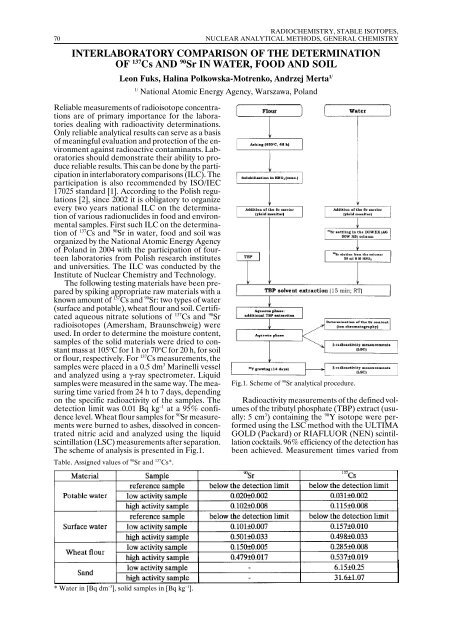annual report annual report annual report annual report 2005
annual report annual report annual report annual report 2005
annual report annual report annual report annual report 2005
Create successful ePaper yourself
Turn your PDF publications into a flip-book with our unique Google optimized e-Paper software.
70<br />
RADIOCHEMISTRY, STABLE ISOTOPES,<br />
NUCLEAR ANALYTICAL METHODS, GENERAL CHEMISTRY<br />
INTERLABORATORY COMPARISON OF THE DETERMINATION<br />
OF 137 Cs AND 90 Sr IN WATER, FOOD AND SOIL<br />
Leon Fuks, Halina Polkowska-Motrenko, Andrzej Merta 1/<br />
1/<br />
National Atomic Energy Agency, Warszawa, Poland<br />
Reliable measurements of radioisotope concentrations<br />
are of primary importance for the laboratories<br />
dealing with radioactivity determinations.<br />
Only reliable analytical results can serve as a basis<br />
of meaningful evaluation and protection of the environment<br />
against radioactive contaminants. Laboratories<br />
should demonstrate their ability to produce<br />
reliable results. This can be done by the participation<br />
in interlaboratory comparisons (ILC). The<br />
participation is also recommended by ISO/IEC<br />
17025 standard [1]. According to the Polish regulations<br />
[2], since 2002 it is obligatory to organize<br />
every two years national ILC on the determination<br />
of various radionuclides in food and environmental<br />
samples. First such ILC on the determination<br />
of 137 Cs and 90 Sr in water, food and soil was<br />
organized by the National Atomic Energy Agency<br />
of Poland in 2004 with the participation of fourteen<br />
laboratories from Polish research institutes<br />
and universities. The ILC was conducted by the<br />
Institute of Nuclear Chemistry and Technology.<br />
The following testing materials have been prepared<br />
by spiking appropriate raw materials with a<br />
known amount of 137 Cs and 90 Sr: two types of water<br />
(surface and potable), wheat flour and soil. Certificated<br />
aqueous nitrate solutions of 137 Cs and 90 Sr<br />
radioisotopes (Amersham, Braunschweig) were<br />
used. In order to determine the moisture content,<br />
samples of the solid materials were dried to constant<br />
mass at 105 o C for 1 h or 70 o C for 20 h, for soil<br />
or flour, respectively. For 137 Cs measurements, the<br />
samples were placed in a 0.5 dm 3 Marinelli vessel<br />
and analyzed using a γ-ray spectrometer. Liquid<br />
samples were measured in the same way. The measuring<br />
time varied from 24 h to 7 days, depending<br />
on the specific radioactivity of the samples. The<br />
detection limit was 0.01 Bq kg –1 at a 95% confidence<br />
level. Wheat flour samples for 90 Sr measurements<br />
were burned to ashes, dissolved in concentrated<br />
nitric acid and analyzed using the liquid<br />
scintillation (LSC) measurements after separation.<br />
The scheme of analysis is presented in Fig.1.<br />
Table. Assigned values of 90 Sr and 137 Cs*.<br />
Fig.1. Scheme of 90 Sr analytical procedure.<br />
Radioactivity measurements of the defined volumes<br />
of the tributyl phosphate (TBP) extract (usually:<br />
5 cm 3 ) containing the 90 Y isotope were performed<br />
using the LSC method with the ULTIMA<br />
GOLD (Packard) or RIAFLUOR (NEN) scintillation<br />
cocktails. 96% efficiency of the detection has<br />
been achieved. Measurement times varied from<br />
* Water in [Bq dm –3 ], solid samples in [Bq kg –1 ].
















